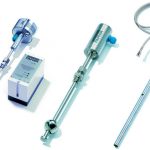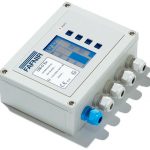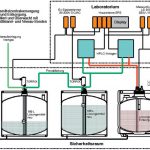Labor-X is a compact filling level sensor series that was developed in cooperation with Merck KGaA. Especially designed for use in laboratories in the chemical, pharmaceutical and food industries, this sensor series simplifies processing of highly pure solvents in operation.
Wolfgang Pajonk, Rupert Roiß
Labor-X comprises various sensor technologies which enable the user to comply with the specific demands of laboratories. Thus, for the first time, an optimal and process-safe sensor concept is available for sensitive liquids.
In addition to non-critical liquids, many highly pure solvents that have to comply with detailed safety regulations concerning storage, processing and disposal are likewise used in laboratories. Filling level sensors employed in connection with solvents have to be explosion-proof. Fafnir designed the complete – and meanwhile certified – Labor-X series with these regulations in mind.
The vessel sizes for laboratory solvents vary from 1 to 5 l bottles and from 10 to 185 l stainless steel barrels.
Vessels are also encountered in the form of steel drums or stainless steel containers as well as PE vessels with a capacity >1,000 l. The Labor-X filling level sensor series from Fafnir was specifically designed for laboratory operators and takes account of the widely diverse vessels that exist in the market. The standardised Labor-X series can be easily installed in any popular vessel type and is compatible with a variety of process connections from different manufacturers.
The Labor-X series offers several measuring methods. Depending on the application and its requirements, it is thus possible to use continuous filling level sensors or sensors for measuring limit signals.
Level sensors and continuous level sensors
The continuous, highly accurate Labor-Torrix filling level sensor is mainly used in laboratory applications, where a central supply system is available for the laboratories. As a rule, the solvent vessels are then stored in a safe room. The various laboratory HPLC plants are supplied via a pipe system. The Torrix level sensor can be directly connected to an internal PLC. If a PLC cannot be connected, the filling level can instead be indicated on a compact measurement analysis device with a graphical display known as UM-X. The field display can be easily connected and programmed using a menu function according to each user’s requirements.
The Labor-Torrix sensor is compatible with all standard container sizes from 10 l. The diagram shows a supply configuration that is suitable for all users whose daily consumption is greater than the vessel volume or if the contents of a barrel are not sufficient for the process when the unit is operated overnight. If additional volume is needed, two or more vessels can be connected in series. This configuration could consist of two 185 l barrels with a suitable drainage system and an internal immersion tube that are connected together by a recovery pipe. The system must be aired by means of an adapter for suction drainage. Drainage by compression is also possible.
Both drums are equipped with the Torrix level sensor. The sensor measuring signals (4…20 mA) are processed in a special PLC, so that users have access to precise information about the liquid volume at all times. By programming freely definable level switching points, a new demand value can be automatically calculated if only a small quantity remains. Moreover, the equipment can turn itself off if the liquid falls below a specified quantity necessary for an analysis. This saves time and cuts costs. The continuous information about consumption enables the capacity of the connected HPLC plants to be optimised. Thanks to this measuring unit, fewer staff are needed to monitor and supply the solvents.
Not only the supply of solvents to the HPLC plants is important but also their subsequent disposal, especially with regard to environmental and safety regulations. The configuration described here allows monitored, automatic disposal. The spent liquids are piped back into empty vessels provided for this purpose in the safe room via the same pipe connections. Since the original volume is approximately equal to the spent volume, the quantity of liquid disposed of can be controlled by means of the two Torrix sensors. The only safety measure needed is a Labor-LS overfill protection device for the disposal vessel.
In addition to continuously monitoring filling quantities, the level sensors in the Labor-LS series for liquid limit control are also suitable for smaller HPLC units. The double drum in the bottom safety cabinet is used to simultaneously supply and dispose of the solvents.
Fafnir level sensors are available in a stand-ard or dual design, depending on their application. The dual design offers an additional, customised level point. The customer thus has the option of measuring a controlled minimum residual quantity over and above the empty reading. Alternatively, this serves as planning information for follow-up orders or to indicate that the remaining quantity is still sufficient to carry out the scheduled analysis. The units can be turned off via floating contacts in the LS 500 transducer or visual and audible signals output.
The filling level of the waste disposal barrel is likewise controlled by a Labor-LS level sensor with an alert signal. When the maximum permitted level is reached, the level sensor either turns off the unit by means of a floating contact in the LS 500 transducer or outputs a warning.
The manufacturer offers an optional alarm display for visual and audible signalling that is mounted directly at the workplace. The audible signal can be acknowledged. If the system is installed in a safety cabinet, Fafnir can also provide an optional fire-proof cable bushing.
Very small quantities of solvents are usually processed in laboratories in 2.5 or 5 l glass bottles. Glass is nowadays gradually being superseded by aluminium or steel for safety reasons. The latter has the advantage that the risk of breakage is virtually zero. A further benefit is that the bottles are more easily transported from the point of view of safety and costs. The disadvantage of these containers compared to glass bottles is that the contents are no longer readily visible to the user.
Limit signal sensor in a bottle
The Fafnir portfolio also includes an efficient, practical and process-safe sensor so-lution for this type of container: the Labor-LS 300 B bottle sensor. The Labor-LS 300 B bottle sensor is installed with an existing GL 45 HPLC bottle distributor, for example. When the sensor is connected to the LS 500 transducer, visual and audible alarms can be transmitted or controls activated during the drainage process. The sensor was specifically designed for HPLC bottle distributors.
Since the measuring point of the sensor is embedded in the tip of the probe rod, it can be precisely adjusted for the application by shifting the rod. These small containers can be included in an automatic analysis process in this way. All units are optionally available without Ex approval for non-explosive liquids.
cpp 452
More informations about Fafnir’s products
Hannover Messe 2008
Share:









